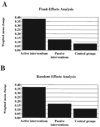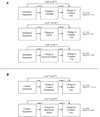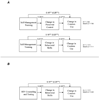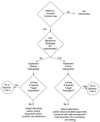A test of major assumptions about behavior change: a comprehensive look at the effects of passive and active HIV-prevention interventions since the beginning of the epidemic
- PMID: 16351327
- PMCID: PMC2713787
- DOI: 10.1037/0033-2909.131.6.856
A test of major assumptions about behavior change: a comprehensive look at the effects of passive and active HIV-prevention interventions since the beginning of the epidemic
Abstract
This meta-analysis tested the major theoretical assumptions about behavior change by examining the outcomes and mediating mechanisms of different preventive strategies in a sample of 354 HIV-prevention interventions and 99 control groups, spanning the past 17 years. There were 2 main conclusions from this extensive review. First, the most effective interventions were those that contained attitudinal arguments, educational information, behavioral skills arguments, and behavioral skills training, whereas the least effective ones were those that attempted to induce fear of HIV. Second, the impact of the interventions and the different strategies behind them was contingent on the gender, age, ethnicity, risk group, and past condom use of the target audience in ways that illuminate the direction of future preventive efforts.
Figures









Similar articles
-
Nature, decay, and spiraling of the effects of fear-inducing arguments and HIV counseling and testing: a meta-analysis of the short- and long-term outcomes of HIV-prevention interventions.Health Psychol. 2007 Jul;26(4):496-506. doi: 10.1037/0278-6133.26.4.496. Health Psychol. 2007. PMID: 17605570 Free PMC article.
-
Health beliefs and promotion of HIV-preventive intentions among teenagers: a Scottish perspective.Health Psychol. 1992;11(6):363-70. doi: 10.1037//0278-6133.11.6.363. Health Psychol. 1992. PMID: 1286655
-
An assessment of brief group interventions to increase condom use by heterosexual crack smokers living with HIV infection.AIDS Care. 2012;24(2):220-31. doi: 10.1080/09540121.2011.597707. Epub 2011 Jul 25. AIDS Care. 2012. PMID: 21780981 Clinical Trial.
-
How can psychological theory help to promote condom use in sub-Saharan African developing countries?J R Soc Health. 1997 Jun;117(3):186-91. doi: 10.1177/146642409711700311. J R Soc Health. 1997. PMID: 9195835 Review.
-
HIV risk reduction behavioral interventions with heterosexual adolescents.AIDS. 2000 Sep;14 Suppl 2:S40-52. AIDS. 2000. PMID: 11061641 Review.
Cited by
-
Modeling and testing maternal and newborn care mHealth interventions: a pilot impact evaluation and follow-up qualitative study in Guatemala.J Am Med Inform Assoc. 2017 Mar 1;24(2):352-360. doi: 10.1093/jamia/ocw102. J Am Med Inform Assoc. 2017. PMID: 27474102 Free PMC article.
-
Social cognitive determinants of ecstasy use to target in evidence-based interventions: a meta-analytical review.Addiction. 2008 Jan;103(1):109-18. doi: 10.1111/j.1360-0443.2007.02041.x. Epub 2007 Nov 12. Addiction. 2008. PMID: 17999706 Free PMC article. Review.
-
Therapist-delivered and self-help interventions for gambling problems: A review of contents.J Behav Addict. 2018 Jun 1;7(2):211-226. doi: 10.1556/2006.7.2018.44. Epub 2018 Jun 13. J Behav Addict. 2018. PMID: 29895185 Free PMC article. Review.
-
Improving the Odds of Success for Precision Medicine Using the Social Ecological Model.AMIA Annu Symp Proc. 2020 Mar 4;2019:1149-1156. eCollection 2019. AMIA Annu Symp Proc. 2020. PMID: 32308912 Free PMC article.
-
Men's condom use resistance: Alcohol effects on theory of planned behavior constructs.Health Psychol. 2016 Feb;35(2):178-86. doi: 10.1037/hea0000269. Epub 2015 Sep 7. Health Psychol. 2016. PMID: 26348499 Free PMC article.
References
-
- Ajzen I. From intentions to actions: A theory of planned behavior. In: Kuhi J, Beckmann J, editors. Action-control: From cognition to behavior. Heildelberg, Germany: Springer; 1985. pp. 11–39.
-
- Ajzen I. The theory of planned behavior. Organizational Behavior and Human Decision Processes. 1991;50:179–211.
-
- Ajzen I. Perceived behavioral control, self-efficacy, locus of control, and the theory of planned behavior. Journal of Applied Social Psychology. 2002;32:665–683.
-
- Ajzen I, Fishbein M. Understanding attitudes and predicting social behavior. Englewood Cliffs, NJ: Prentice Hall; 1980.
-
- Ajzen I, Madden TJ. Prediction of goal-directed behavior: Attitudes, intentions, and perceived behavioral control. Journal of Experimental Social Psychology. 1986;22:453–474.
Publication types
MeSH terms
Grants and funding
LinkOut - more resources
Full Text Sources
Medical
Miscellaneous

